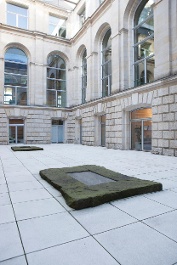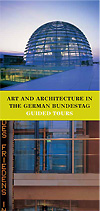Navigationspfad: Homepage > Art and History > Art > Artists
Ulrich Rückriem
born in Düsseldorf in 1938, lives and works in Clonegal, Ireland.
The ideas behind Rückriem’s two floor sculptures in the south courtyard, and their proportions, comment on and develop the architecture of the site. The artist had two pieces separated from a block of Normandy granite and cut each of them into five slabs. He then arranged the slabs in their original positions and aligned them with the lines of the paving stones on the floor of the courtyard.
He had previously mill-cut, ground and polished the slab in the middle, giving it a blue-grey reflecting surface that makes the rusty-grey surrounding slabs appear like the edge of a fountain or well.
Rückriem contrasts the dressed stone of Paul Wallot’s Reichstag Building with natural, undressed granite and, in doing so, takes one feature of Wallot’s architecture a step further: the rustication of the lower courtyard storey, with its irregular, apparently undressed surfaces, gives the impression of rugged naturalness, whereas Rückriem’s granite slabs are genuinely natural.
At the same time his sculptures reveal the process of their making: the holes drilled to separate the pieces of granite from the block can be discerned at the outer edges, while the juxtaposition of dressed and undressed slabs intensifies the material qualities of the granite.
Rückriem trained as a stonemason, finishing his apprenticeship in the workshop responsible for the upkeep of Cologne Cathedral. In the 1960s and 1970s, he acquired a reputation as one of Germany’s leading sculptors. Notably rigorous in his approach, Rückriem ceased using teel and wood in 1980 to concentrate on stone and, more recently, granite.
He is equally radical in his refusal to let his sculpture be interpreted in any but artistic terms, seeing himself as a formalist who creates self-contained works of art that focus on materials and the processes of working them: ‘The material, its form, characteristics and proportions influence and circumscribe my creative activity. – Work processes should remain visible and their traces not be erased by subsequent interventions. – My working of the material determines the nature of the object and its relationship to its new surroundings.’
The two floor sculptures in the south courtyard of the Reichstag Building embody this approach in characteristically austere fashion, their severity resulting from the artist’s exclusive concentration on proportion, the effect of the material and the traces of its working.



